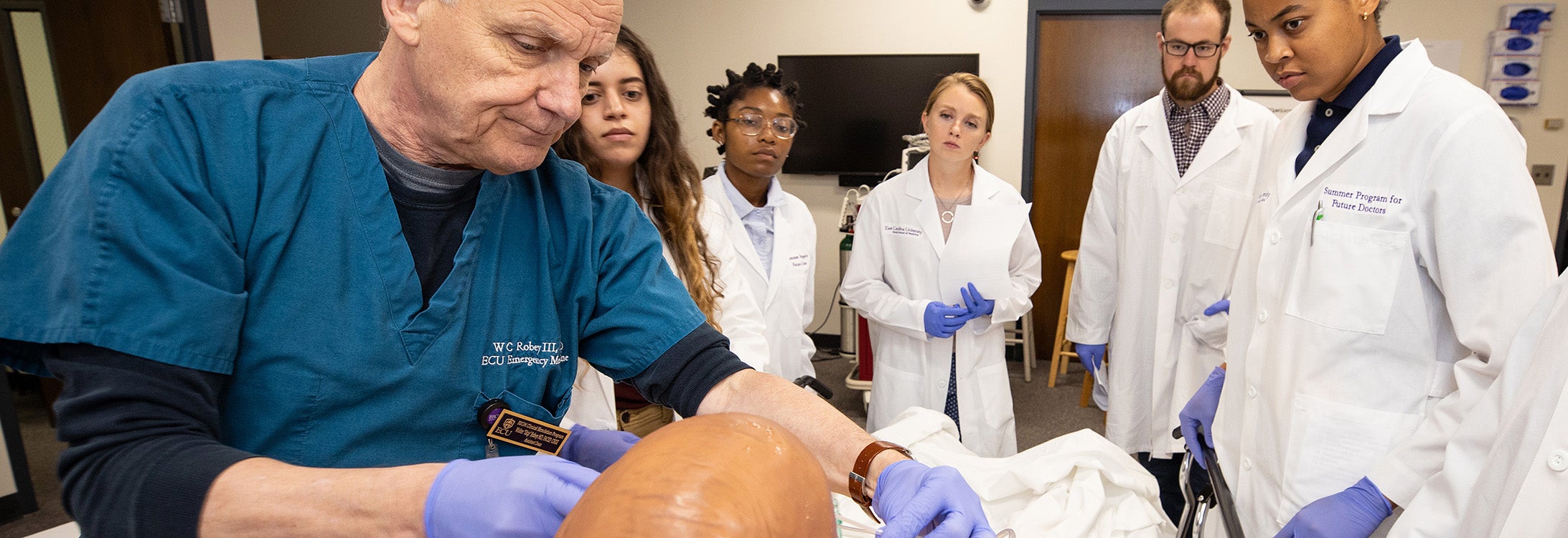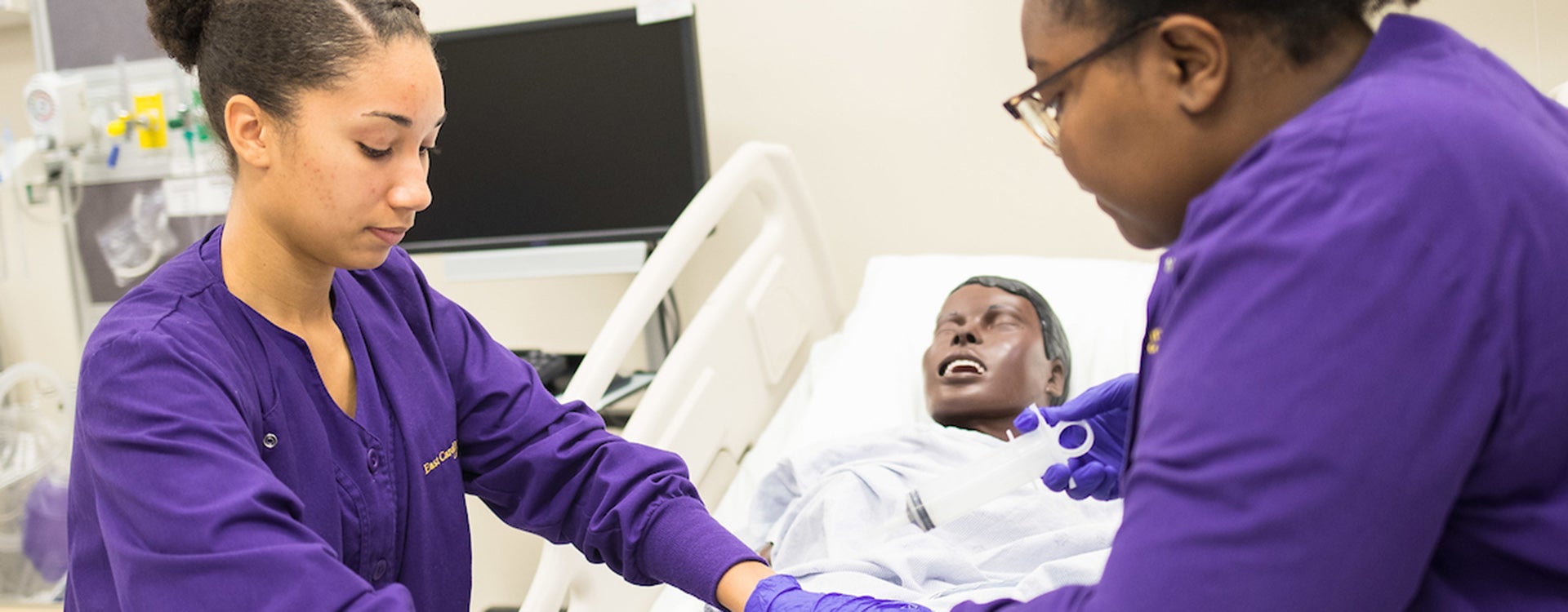CELEBRATING SIMULATION
Health sciences division marks Healthcare Simulation Week
For ECU dental student Toyosi Coker and other students on the Health Sciences Campus, practice makes a perfect blend of confidence and capability.
Access to state-of-the-art equipment and technology in simulation labs means students receive hands-on training to refine the skills necessary for specific procedures and grow comfortable in clinical settings.
Those invaluable experiences are being celebrated this week as part of Healthcare Simulation Week, a global observation of simulation as a tool to improve the safety, effectiveness and efficiency of health-care delivery. The week is also meant to raise national awareness of how health-care simulation leads to safer, more knowledgeable patient care among professionals and students.
“It’s very helpful to be able to go through the motions of each procedure and become comfortable with the instruments and equipment that we have available to us,” said Coker, from Raleigh, a second-year student in the ECU School of Dental Medicine. “Our sim lab pods house manikins and technology that are set up to simulate the way our operatories in clinic will be arranged. Once we begin interacting with live patients, there will be several other factors to consider—so having the comfort of knowing the general operatory set-up will help ease the initial nerves and get us quickly and confidently integrated into clinic practice.”
During Dr. Mahmoud Serag’s Fixed Prosthodontics course last week, Coker and other students used manikins to practice preparing teeth that are planned to receive a crown or a bridge. Serag paused to answer questions and observe students practicing the techniques.
“Faculty members and I are always impressed with how fast the students develop their knowledge and hand skills with the help of latest technologies and modern equipment,” he said. “The School of Dental Medicine ensures that its graduates are properly equipped with the knowledge and skills that would make them great clinicians.”
The simulation labs on the Health Sciences Campus not only provide manikins for training, but also mimic real clinical settings that factor in workplace ergonomics and positioning. Students also have opportunities to learn based on the professional experiences of faculty.
“My favorite part about learning the hands-on techniques with different faculty in the sim lab is the variety of opinions and feedback that you get,” said second-year SoDM student Chandler Conner, from Rockingham. “Each faculty member has a different background, specialty and level of experience, which allows you to see your work through various perspectives. It is nice to know that you are learning from the best.”
The College of Nursing also houses state-of-the-art simulation technology in training its students to combine technical concepts and critical thinking skills as they prepare to provide quality patient care. The school’s Concepts Integrations Labs are equipped with including dozens of manikins, compressed air to allow simulation of medical air, oxygen and suction, stand-up computer stations and computers that operate video and sound recording and playback for debriefing in each lab space. During the 2017-2018 academic year, nearly 160 simulations were performed in the College of Nursing’s labs.
According to the Society for Simulation in Healthcare, which was founded to improve performance and reduce errors in patient care through simulation, the purpose of incorporating such activities into the student experience has four purposes – education, research, assessment and health system integration in facilitating patient safety.
“Simulations may also add to our understanding of human behavior in the true-to-life settings in which professionals operate,” according to the society’s website.
Becky Gilbird, director of the Interprofessional Clinical Simulation Program at the Brody School of Medicine, said simulation provides students real-world scenarios that they can practice in a secure setting.
“Simulation gives students hands-on training and allows them to practice what they learned in a classroom before interacting with a real patient,” she said. “We want the students to learn in a safe environment before getting into a real situation where the stakes are much higher.”
The Simulation Center is an integral part of Brody’s curriculum. Each medical student participates in a minimum of 26 simulation and skills sessions before graduation. There are also self-study opportunities for medical students to aid in preparation for board exams, collaborate with simulation faculty for research initiatives and get additional hands-on experience.
The center also offers interprofessional programs that include students from other universities and other ECU Health Sciences colleges and schools, as well as practicing providers from Vidant Medical Center. Students exploring health sciences professions also get to experience what the center has to offer. Brody’s Summer Program for Future Doctors includes activities in the Simulation Center for students considering medical careers.
The center’s mobile Healthcare Simulation Unit takes outreach and education on the road, traveling through eastern North Carolina to educate health care professionals on a variety of topics including pediatric trauma, stroke identification and response and sedation of dental patients. Topics are usually timely to what medical professionals may encounter in the field.
“One of our newer programs educates community members on how to respond to a potential opioid overdose,” Gilbird said. “We have even collaborated with local military to train medical personnel prior to deployment.”
Gilbird said she hopes having a week set aside to highlight health sciences simulation will encourage Division of Health Sciences offices to explore potential collaborations with the Simulation Center in education, research and grants. Observing Healthcare Simulation Week is a way to celebrate those unique partnerships among professionals, but also to build confidence and trust among future patients.
“Simulation brings together physicians, nurses and other health professionals to train together and improve patient care. An example is our collaboration with the ECU College of Nursing Concepts Integration Lab and Vidant Medical Center,” Gilbird said. “It’s important for patients to know their providers have trained in realistic environments and have access to ongoing education.”

